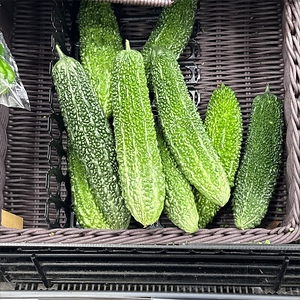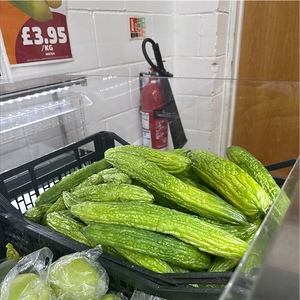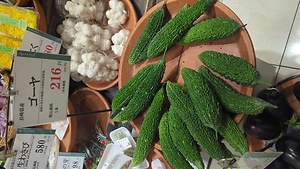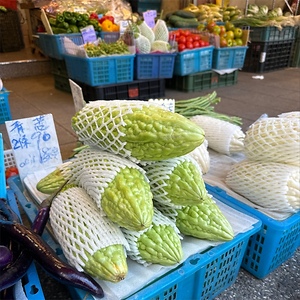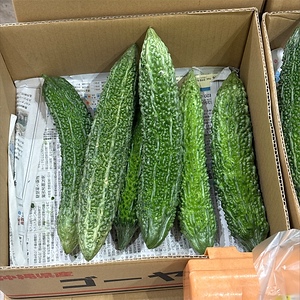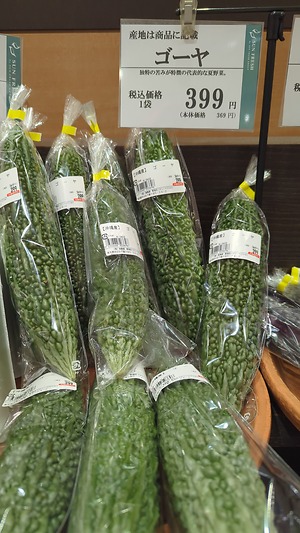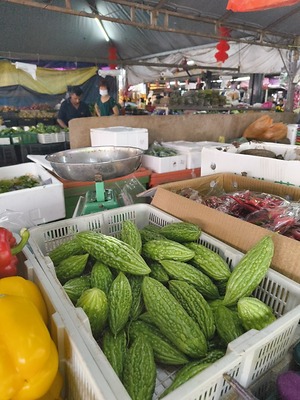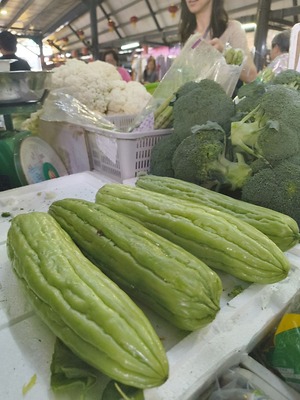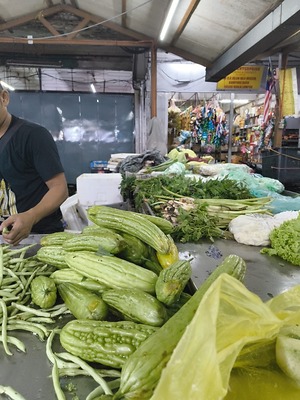

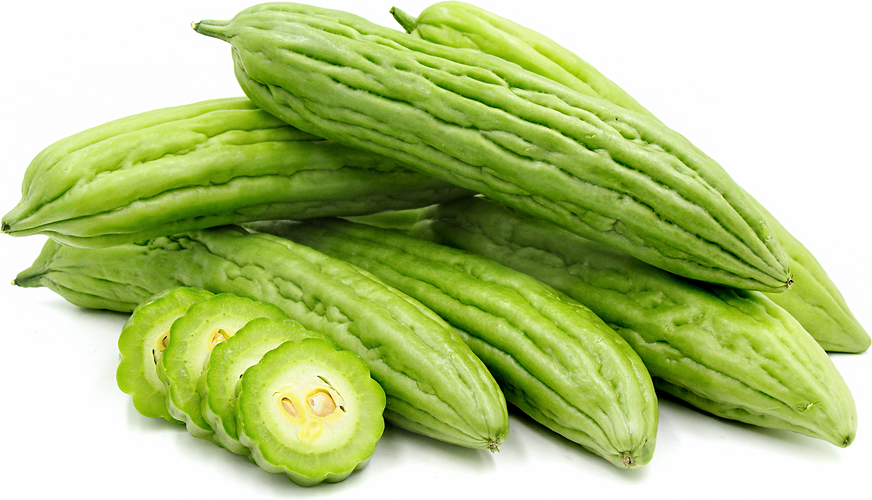
Bitter Melons
Estimated Inventory, 10 lbs : 0
This item was last sold on : 03/05/25
Description/Taste
Bitter melons vary in size and shape, depending on the specific variety and growing region. Cultivars average 20 to 30 centimeters in length and typically have a straight to slightly curved, oblong, tapered shape. The light green skin is covered in defined but shallow ridges, bumps, and grooves and has a waxy feel. Chinese Bitter melons have a smoother appearance than Indian Bitter melon types, and the skin is edible, not needing to be peeled. Both kinds are considered Green Bitter melons. Underneath the exterior, Bitter melons bear a layer of pale green flesh encasing a central seed cavity. The seed cavity is filled with spongy ivory to white pulp and large white to brown seeds. The seeds will develop a red fleshy coating as the fruit matures, and the exterior will become orange. Bitter melon flesh is crisp, aqueous, and crunchy with a refreshing and tender consistency, reminiscent of a cucumber when fresh. The flesh is edible raw or cooked and has a vegetal, green bean-like taste with bitter nuances. Younger and smaller Bitter melons will be less pungent than larger, more mature fruits.
Seasons/Availability
Bitter melons are available year-round, with a peak season in the summer and fall.
Current Facts
Bitter melons, botanically classified as Momordica charantia, are a category of multiple varieties of fruits used for culinary purposes belonging to the Cucurbitaceae family. The species encompasses cultivars found in two main colorings: green and white. Green Bitter melons can be further divided into Chinese and Indian types. Chinese Bitter melons, as depicted in the photograph above, are larger and have smoother, pale green skin, while Indian varieties tend to be narrower, darker green, and have a bumpier, rigid surface. Chinese Bitter melons are known by several names worldwide, including Bitter gourd in English, Kǔguā and Ku Gua in Mandarin, Nigauri and Goya in Japanese, Muop Dang and Kho Qua in Vietnamese, Peria Katak in Malaysian, Ampalaya in Filipino, and Caraili, Carilley, and Karilli in regions throughout the Caribbean. Bitter melons develop on fast-growing, climbing vines, and even though they are botanically fruits, they are prepared like vegetables in culinary preparations. Bitter melons are a medicinal and culinary staple throughout Asia and are a favored seasonal summer ingredient for their cooling nature and pungent taste. The species has also spread in cultivation worldwide and is slowly being incorporated into a wide array of savory culinary dishes.
Nutritional Value
Bitter melons, in general, are believed to have cooling properties in Traditional Chinese Medicine, especially when eaten on hot days during the summer. The species is also thought to help detox the body and control blood sugar levels, while containing antioxidant and anti-inflammatory properties. Bitter melon flesh is customarily sliced and added to boiling water as a tea. Dried pieces are also used for a more mellow flavor. Bitter melons provide fiber to aid digestion and vitamins A, B, and C to contribute to energy production in the body, strengthen the immune system, and maintain healthy organs. Bitter melons also have minerals like iron, potassium, calcium, phosphorus, and magnesium. Iron develops the protein hemoglobin for oxygen transport through the bloodstream, while potassium balances fluid levels within the body. Calcium and phosphorus support bone and teeth development, and magnesium helps control daily nerve functions. The species' bitter taste is derived from cucurbitacin, a natural compound used as a defense method against pests. These compounds taste bitter and appear at varying levels, depending on the specific variety.
Applications
Bitter melons have an astringent, bitter, and vegetal taste for cooked preparations. The species can be eaten raw, but most consumers say their bitter taste is too strong without prior cooking. Bitter melons are sometimes juiced and mixed with sweeter flavorings like pineapple and apple as a morning health drink. The fruits should be washed, sliced in half, and the center pulp and seeds removed. The flesh is finely cut into small, angled pieces and is soaked in salt or blanched to lessen the bitterness. Once the bitterness is reduced, Bitter melons are added to salads, chopped into dips and spreads, or tossed with chili sauces and pastes as a side dish. Throughout Asia, Bitter melons are commonly stir-fried, simmered, steamed, or braised. The variety’s sharp flavor complements rich, fatty, and spicy ingredients and is often stir-fried with eggs, pork, and other meats. In China and Taiwan, Bitter melon is cooked in a black bean sauce or with salted duck eggs. Bitter melon and egg dishes are also made with coconut milk in Malaysia and Indonesia, with tomatoes and oyster sauce in the Philippines, or with tofu, spices, and pork in Japan in the famous Okinawan dish goya champuru. Beyond stir-frying, Bitter melons are pickled or stuffed with minced meat, mushrooms, and noodles and later steamed or braised, as seen in Vietnam during New Year celebrations. They are also simmered into soups, stews, and curries. In Taiwan, Bitter melons are occasionally added to pineapple and chicken soup, and in the Philippines, they are incorporated into pinakbet. In Thailand, the fruits are cooked with pork, garlic, and spices in a light, clear broth. Outside of Asia, Bitter melons are cooked with spicy chile peppers and aromatics in the Caribbean or stuffed and covered in rich sauces. Bitter melons pair well with aromatics, including lemongrass, ginger, garlic, and onions, meats like pork, beef, and poultry, and seafood such as fish, shrimp, crab, and scallops. Whole, unwashed Bitter melons will keep for 3 to 5 days when wrapped in plastic or placed in a sealed container in the refrigerator’s crisper drawer.
Ethnic/Cultural Info
Bitter melons are nicknamed the “gentleman’s vegetable” in China. Despite their strong, bitter taste, this flavor is not leeched into other ingredients during the cooking process. Bitter melons were allegedly first given this nickname during the early Qing Dynasty by scholar Qu Dajun. In his work “Guangdong Xinyu,” Qu Dajun references Bitter melons and notes that the flavor does not permeate the dish. He wrote, “It is bitter for itself but not for others, which is the virtue of a gentleman." The nickname of being a gentleman stuck for the species, and the name is still heard in markets in China in the present day.
Geography/History
Bitter melons are native to Asia, with hypothesized centers of origin in South and Southeast Asia. The exact history of the wild species is still somewhat debated, but over time, cultivated types appeared from selective breeding throughout Asia. Bitter melons have historically been grown for medicinal and culinary uses, and many new and improved varieties have been developed for increased cultivation and consumer appeal. By the late 20th century, it was estimated that over 177 Bitter melon strains were present in breeding programs in China. Today, Bitter melons have expanded in cultivation to tropical and subtropical growing regions worldwide. Centralized production is still mainly localized to Asia, and varieties are planted in commercial and home gardens. When in season, Bitter melons are sold fresh through local markets, retailers, and wholesalers.
Recipe Ideas
Recipes that include Bitter Melons. One



